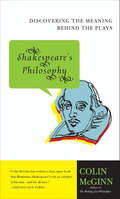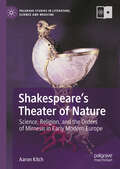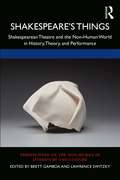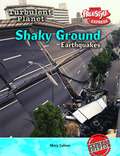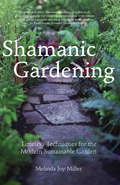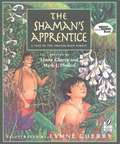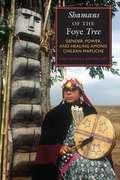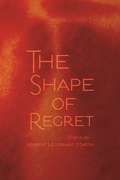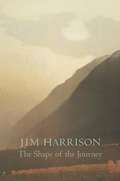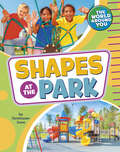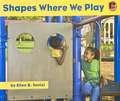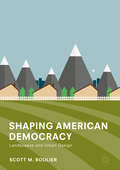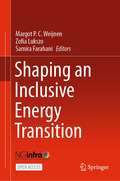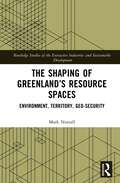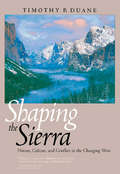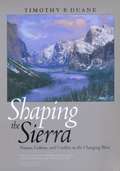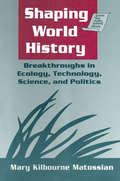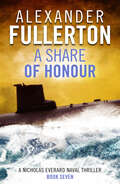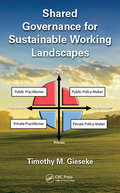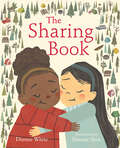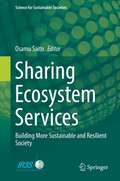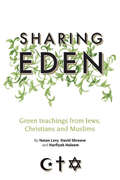- Table View
- List View
Shakespeare's Philosophy: Discovering the Meaning Behind the Plays
by Colin McGinnShakespeare’s plays are usually studied by literary scholars and historians and the books about him from those perspectives are legion. It is most unusual for a trained philosopher to give us his insight, as Colin McGinn does here, into six of Shakespeare’s greatest plays–A Midsummer Night’s Dream, Hamlet, Othello, Macbeth, King Lear, and The Tempest. In his brilliant commentary, McGinn explores Shakespeare’s philosophy of life and illustrates how he was influenced, for example, by the essays of Montaigne that were translated into English while Shakespeare was writing. In addition to chapters on the great plays, there are also essays on Shakespeare and gender and his plays from the aspects of psychology, ethics, and tragedy.As McGinn says about Shakespeare, “There is not a sentimental bone in his body. He has the curiosity of a scientist, the judgment of a philosopher, and the soul of a poet.” McGinn relates the ideas in the plays to the later philosophers such as David Hume and the modern commentaries of critics such as Harold Bloom. The book is an exhilarating reading experience, especially for students who are discovering the greatest writer in English.
Shakespeare’s Theater of Nature: Science, Religion, and the Orders of Mimesis in Early Modern Europe (Palgrave Studies in Literature, Science and Medicine)
by Aaron KitchShakespeare’s Theater of Nature argues that Shakespeare combined art and nature in new ways while experimenting with relations between words, images, and objects as sources of knowledge and pleasure. Shakespeare’s re-centering of nature as a source of theatrical representation in a range of plays follows debates in natural philosophy and theology about how to understand divinity in and through the order of nature (ordo creationis). Early chapters analyze early modern reframing of nature by printed books of botany, cosmology, and history—as well Tudor interludes that center nature as a subject—while later chapters offer readings of eight plays by Shakespeare that draw on classical, medieval, and early modern debates in natural philosophy and theology to create new modes of dramatic mimesis.
Shakespeare’s Things: Shakespearean Theatre and the Non-Human World in History, Theory, and Performance (Perspectives on the Non-Human in Literature and Culture)
by Brett Gamboa Lawrence SwitzkyFloating daggers, enchanted handkerchiefs, supernatural storms, and moving statues have tantalized Shakespeare’s readers and audiences for centuries. The essays in Shakespeare’s Things: Shakespearean Theatre and the Non-Human World in History, Theory, and Performance renew attention to non-human influence and agency in the plays, exploring how Shakespeare anticipates new materialist thought, thing theory, and object studies while presenting accounts of intention, action, and expression that we have not yet noticed or named. By focusing on the things that populate the plays—from commodities to props, corpses to relics—they find that canonical Shakespeare, inventor of the human, gives way to a lesser-known figure, a chronicler of the ceaseless collaboration among persons, language, the stage, the object world, audiences, the weather, the earth, and the heavens.
Shaky Ground: Earthquakes (Turbulent Planet)
by Mary ColsonImagine it is the middle of the night and you are fast asleep in bed. Suddenly you are jolted awake. Your heart races. The walls and floor are shaking. The bed is lifting into the air. Furniture is sliding. The glass in your window cracks and splinters. Your ears are deafened by crashes and bangs. The ground continues to shake. Outside, buildings crumble and roads split open. Bridges collapse and railway lines buckle. Gas and water pipes burst. There is no electricity and the phones are dead. Fires break out. Thick, black smoke makes it difficult to see and hard to breathe. What is happening? You are in the middle of an earthquake.
Shalom and the Community of Creation: An Indigenous Vision (Prophetic Christianity Series (PC))
by Randy WoodleyMaterialism. Greed. Loneliness. A manic pace. Abuse of the natural world. Inequality. Injustice. War. The endemic problems facing America today are staggering. We need change and restoration. But where to begin? In Shalom and the Community of Creation Randy Woodley offers an answer: learn more about the Native American 'Harmony Way,' a concept that closely parallels biblical shalom. Doing so can bring reconciliation between Euro-Westerners and indigenous peoples, a new connectedness with the Creator and creation, an end to imperial warfare, the ability to live in the moment, justice, restoration -- and a more biblically authentic spirituality. Rooted in redemptive correction, this book calls for true partnership through the co-creation of new theological systems that foster wholeness and peace.
Shamanic Gardening
by Melinda Joy MillerA shaman is one who walks in two worlds, one seen easily by everyone, another seen with the senses of the heart, deep recesses of the mind, and within the collective spiritual consciousness. Shamanic Gardening integrates sustainable ancient and traditional gardening methods with shamanic principles and modern permaculture. The practices, history, myths, recipes, and philosophies inside this book will enhance your relationship with nature, sustain the earth, delight your senses, and nourish your soul. Shamanic Gardening includes a cultural history of sustainable gardening, including gardening techniques used by Cleopatra, the Japanese, The Pueblo Indians, George Washington and Thomas Jefferson, and many others. This book teaches both simple and advanced techniques to garden with more awareness and effectiveness, using your inner senses. Learn to design an elegant, edible, sustainable landscape, plant for nutrition and beauty, grow healing herbs and aphrodisiacs, work with earth energies and color, extract flower essences, and much more. Melinda Joy Miller is a feng shui master, cultural anthropologist, medicine woman, and Keeper of the Medicine Wheel of Peace teachings of the Senecas. She has been practicing and teaching permaculture techniques and shamanic healing for over thirty years.
The Shamans Apprentice
by Lynne CherryFor thousands of years, in the jungles of the Amazon, shamans have passed their wisdom of the medicinal values of rain forest plants from one generation to the next. The Shaman's Apprenticetells the story of a Tirio Indian boy who dreams of one day being the tribal shaman, and how he and his people learn the importance of their own knowledge about the healing properties of the rain forest.
Shamans of the Foye Tree
by Ana Mariella BacigalupoDrawing on anthropologist Ana Mariella Bacigalupo's fifteen years of field research, Shamans of the Foye Tree: Gender, Power, and Healing among Chilean Mapuche is the first study to follow shamans' gender identities and performance in a variety of ritual, social, sexual, and political contexts. To Mapuche shamans, or machi, the foye tree is of special importance, not only for its medicinal qualities but also because of its hermaphroditic flowers, which reflect the gender-shifting components of machi healing practices. Framed by the cultural constructions of gender and identity, Bacigalupo's fascinating findings span the ways in which the Chilean state stigmatizes the machi as witches and sexual deviants; how shamans use paradoxical discourses about gender to legitimatize themselves as healers and, at the same time, as modern men and women; the tree's political use as a symbol of resistance to national ideologies; and other components of these rich traditions. The first comprehensive study on Mapuche shamans' gendered practices, Shamans of the Foye Tree offers new perspectives on this crucial intersection of spiritual, social, and political power.
The Shape of Regret
by Herbert Woodward MartinThe Shape of Regret is a new poetry collection with a long shelf life, something that will be whispered about—gossiped about—by creative readers and writers for years to come. Herbert Woodward Martin is an acclaimed professor and influential American poet who has been known to inspire and encourage. To create his poems, Martin draws from his own life, experiences, and passions. Many of the poems speak directly or indirectly to poets who have shaped or interested Martin, including Hart Crane, William Carlos Williams, Lucille Clifton, Jackson Mac Low, and Robert Frost. He also gives further voice and testimony to the African American experience both in the present and the past. An early reader of the collection said that Martin "continues to contribute to the canon. As an African American poet, he incorporates voices, a range of perspectives, and a unique approach to conveying and incorporating culture into literary language." Martin has been clear that his intention with this collection is to gather as many interesting ideas as possible in one place. His aim is, and has always been, to witness a thriving poetry community—one in which poets of all backgrounds can learn from each other and continue to grow together. The Shape of Regret is a wonderful place to either start or revive one’s love of poetry.
The Shape of the Journey
by Jim HarrisonHere is the definitive collection of poetry from one of America's best-loved writers-now available in paperback. With the publication of this book, eight volumes of poetry were brought back into print, including the early nature-based lyrics of Plain Song, the explosive Outlyer & Ghazals, and the startling "correspondence" with a dead Russian poet in Letters to Yesenin. Also included is an introduction by Harrison, several previously uncollected poems, and "Geo-Bestiary," a 34-part paean to earthly passions. The Shape of the Journey confirms Jim Harrison's place among the most brilliant and essential poets writing today."Behind the words one always feels the presence of a passionate, exuberant man who is at the same time possessed of a quick, subtle intelligence and a deeply questioning attitude toward life. Harrison writes so winningly that one is simply content to be in the presence of a writer this vital, this large-spirited."--The New York Times Book Review"(An) untrammelled renegade genius... here's a poet talking to you instead of around himself, while doing absolutely brilliant and outrageous things with language."-Publishers Weekly"Readers can wander the woods of this collection for a lifetime and still be amazed at what they find."-Booklist (starred review.)When first published, this book immediately became one of Copper Canyon Press's all-time bestsellers. It was featured on Garrison Keillor's Writer's Almanac, became a finalist for the Los Angeles Times Book Prize, and was selected as one of the "Top-Ten Books of 1998" by Booklist.Jim Harrison is the author of twenty books, including Legends of the Fall and The Road Home. He has also written numerous screenplays and served as the food columnist for Esquire magazine. He lives in Michigan and Arizona.Dead DeerAmid pale green milkweed, wild clover, a rotted deer curled, shaglike, after a winter so cold the trees split open. I think she couldn't keep up with the others (they had no place to go) and her food, frozen grass and twigs,
Shapes at the Park (The World Around You)
by Christianne JonesFrom rectangular ladders to circular rings and hexagonal picnic tables, the park is full of shapes! Finding shapes adds even more fun to a day at the park, and early learners will be fully engaged with the interactive, rhyming text and colorful photos in this picture book.
Shaping American Democracy: Landscapes and Urban Design
by Scott M. RoulierThis book argues that the design of built spaces influences civic attitudes, including prospects for social equality and integration, in America. Key American architects and planners--including Frederick Law Olmsted, Frank Lloyd Wright, Robert Moses, and the New Urbanists--not only articulated unique visions of democracy in their extensive writings, but also instantiated those ideas in physical form. Using criteria such as the formation of social capital, support for human capabilities, and environmental sustainability, the book argues that the designs most closely associated with a communally-inflected version of democracy, such as Olmsted's public parks or various New Urbanist projects, create conditions more favorable to human flourishing and more consistent with a democratic society than those that are individualistic in their orientation, such as urban modernism or most suburban forms.
Shaping an Inclusive Energy Transition
by Margot P. C. Weijnen Zofia Lukszo Samira FarahaniThis open access book makes a case for a socially inclusive energy transition and illustrates how engineering and public policy professionals can contribute to shaping an inclusive energy transition, building on a socio-technical systems engineering approach. Accomplishing a net-zero greenhouse gas emissions economy in 2050 is a daunting challenge. This book explores the challenges of the energy transition from the perspectives of technological innovation, public policy, social values and ethics. It elaborates on two particular gaps in the design of public policy interventions focused on decarbonization of the energy system and discusses how both could be remedied. First, the siloed organization of public administration fails to account for the many interdependencies between the energy sector, the mobility system, digital infrastructure and the built environment. Cross-sector coordination of policies and policy instruments is needed to avoid potentially adverse effects upon society and the economy, which may hamper the energy transition rather than accelerate it. Second, energy and climate policies pay insufficient attention to the social values at stake in the energy transition. In addressing these gaps, this book intends to inspire decision makers engaged in the energy transition to embrace the transition as an opportunity to bring a more inclusive society into being.
The Shaping of Greenland’s Resource Spaces: Environment, Territory, Geo-Security (Routledge Studies of the Extractive Industries and Sustainable Development)
by Mark NuttallThe book examines ideas about the making and shaping of Greenland’s society, environment, and resource spaces. It discusses how Greenland’s resources have been extracted at different points in its history, shows how acquiring knowledge of subsurface environments has been crucial for matters of securitisation, and explores how the country is being imagined as an emerging frontier with vast mineral reserves. The book delves into the history and contemporary practice of geological exploration and considers the politics and corporate activities that frame discussion about extractive industries and resource zones. It touches upon resource policies, the nature of social and environmental assessments, and permitting processes, while the environmental and social effects of extractive industries are considered, alongside an assessment of the status of current and planned resource projects. In its exploration of the nature and place of territory and the subterranean in political and economic narratives, the book shows how the making of Greenland has and continues to be bound up with the shaping of resource spaces and with ambitions to extract resources from them. Yet the book shows that plans for extractive industries remain controversial. It concludes by considering the prospects for future development and debates on conservation and Indigenous rights, with reflections on how and where Greenland is positioned in the geopolitics of environmental governance and geo-security in the Arctic. This book will be of great interest to students and scholars of environmental anthropology, geography, resource management, extractive industries, environmental governance, international relations, geopolitics, Arctic studies, and sustainable development.
Shaping the Future of Small Islands: Roadmap for Sustainable Development
by Shyam Nath John Laing Roberts Satya Paul Yeti Nisha MadhooThe book provides fresh look at the issues of sustainable development, degradation of natural resources and vulnerability to climate change in Small Island developing states (SIDS). It documents the deteriorating state of SIDS and adaptation efforts made to address the impending crisis of unsustainable economic growth with international, national and community support. Authors have discussed issues like macroeconomic trends, vulnerability, resilience capability, and SIDS-specific strategies focusing on sectors like trade and tourism. Discussion continues with the examination of democracy, social capital, quality of life, and health concerns. Climate change and natural resource challenges are analyzed using case studies. The book also discusses diplomatic complexities of international climate agreements, collective action and institutional quality constitute the analysis of global environment and sustainable development.
Shaping the Sierra
by Timothy P. DuaneThe rural west is at a crossroads, and the Sierra Nevada is at the center of this social and economic change. The Sierra Nevada landscape has always been valued for its bounty of natural resource commodities, but new residents and an ever-growing flood of tourists to the area have transformed the relationship between the region's nature and its culture. In an engaging narrative that melds the personal with the professional, Timothy P. Duane--who grew up in the area--documents the impact of rapid population growth on the culture, economy, and ecology of the Sierra Nevada since the late 1960s. He also recommends innovative policies for mitigating the negative effects of future population growth in this spectacular but threatened region, as well as throughout the rural west. Today, the primary social and economic values of the Sierra Nevada landscape are in the amenities and ecological services provided by its wildlands and functioning ecosystems. Duane shows how further unfettered population growth threatens the very values which have made the Sierra Nevada a desirable place to live and work. A new approach to land use planning, resource management, and local economic development--one that recognizes the emerging values of the landscape--is necessary in order to achieve sustainable development, Duane claims. Weaving personal experience with outstanding scholarship, he shows how such an approach must explicitly recognize the importance of values and the application of an environmental land ethic to future development in the area.
Shaping the Sierra: Nature, Culture and Conflict in the Changing West
by Timothy P. DuaneThis book explores the social, economic, and ecological transformation of the Sierra Nevada over the past three decades. Duane emphasizes the need for a new approach to land use planning, resource management, and local economic development.
Shaping World History: Breakthroughs In Ecology, Technology, Science, And Politics (Sources And Studies In World History Ser.)
by Mary Kilbourne MatossianThis innovative survey of world history from earliest times to the present focuses on the role of four factors in the development of humankind: climate, communication and transportation technology, scientific advances, and the competence of political elites. Matossian moves chronologically through fifteen historic periods showing how one or more of the causative factors led to significant breakthroughs in human history. Shaping World History is based on original research and also draws widely from the literature on the history of science, technology, climate, agriculture, and historical epidemiology. This compelling analysis is presented in a personal style and includes reflections on how things work and why they are important.
A Share of Honour (Nicholas Everard Naval Thrillers #4)
by Alexander FullertonDanger lurks beneath the Mediterranean waves… Sub-lieutenant Paul Everard serves in the Mediterranean aboard the submarine Ultra, helping the Allies attack Axis supply ships in a life or death struggle beneath the waves. But Paul has other worries: his father, Nick, is somewhere in the Far East, at risk from the rapidly advancing Japanese. His brother, Jack, has become embroiled in the murky world of clandestine operations, and been sent on a high-risk mission to destroy a key German naval base.The Everards are risking everything for the war. But what price is too high for one family to bear? The seventh instalment of the Nicholas Everard Naval Thrillers is a searing adventure of warfare at sea, perfect for fans of Alan Evans and David McDine.Praise for The Nicholas Everard Naval Thrillers‘The prose has a real sense of urgency, and so has the theme. The tension rarely slackens.’ Times Literary Supplement‘The research is unimpeachable and the scent of battle quite overpowering.’ The Sunday Times‘The accuracy and flair of Forester at his best… carefully crafted, exciting and full of patiently assembled technical detail that never intrudes on a good narrative line’ Irish Times
Shared Borders, Shared Waters: Israeli-Palestinian and Colorado River Basin Water Challenges
by Sharon B. Megdal Robert G. Varady Susanna EdenThis collection of papers examines water management in two of the worlds prominent, arid transboundary areas facing similar challenges. In the Middle East, the chronically water-short Israeli-Palestinian region has recognized the need both to conserve and supplement its traditional water sources. Across the globe on the North American continent, A
Shared Governance for Sustainable Working Landscapes
by Timothy M. GiesekeSustaining our agricultural landscapes is no longer just a technical, scientific or even political problem, but it has evolved into a socially complex, so-called wicked problem of conflicting social governance and economics. This creates an extreme economic obstacle where the value of ecosystem services remains low and diffuse and the transactions costs remain high and multiple.Using Uber-like business platform technology and a shared governance model, a symbiotic demand for environmental benefits is created. Enabling multi-sector transactions for environmental benefits, this platform innovation would remedy the "tragedy of the commons"; the economic nemesis to achieving landscape sustainability. In a nutshell, to sustain our agricultural landscapes a transdisciplinary approach supported by a shared governance model housed within a multi-sided platform in needed. This book introduces an assessment framework identifying governance actors, styles and ratios for socio-ecological systems. The assessment uses a new governance compass to identify the types of actors completing which tasks and identifies the styles of governance used to complete the tasks. It is aimed to anyone involved in sustainability science, agricultural policy planning, or integrated landscape design.
The Sharing Book
by Dianne WhiteA simple story about the little acts of sharing and kindness that make a day special.A hand is perfect for holding.A smile is just right for hello. A pinkie is waiting to promise and FRIENDS, best friends, are for sharing.Come join two best friends on a camping trip as they share the wonderful things they do outdoors with family and friends: meals, laughter, adventures, stories, campfire songs. All the things that make an outdoor experience exciting and memorable. But the most important thing—love—more than anything else, is always for sharing.
Sharing Ecosystem Services: Building More Sustainable and Resilient Society (Science for Sustainable Societies)
by Osamu SaitoUsing “the sharing paradigm” as a guiding concept, this book demonstrates that “sharing” has much greater potential to make rural society resilient, sustainable and inclusive through enriching all four sharing dimensions: informal, mediated, communal and commercial sharing. The chapters are divided into two parts, one that focuses on case studies of the sharing ecosystem services in Japan, the other on case studies from around the world including in the regions of Africa, Asia-Pacific, South America and Europe. Reflecting the recent growing attention to sharing concept and its application to economic and urban context, this publication explores opportunities and challenges to build more resilient and sustainable society in harmony with nature by critical examination of sharing practices in rural landscapes and seascapes around the world. This book introduces not only traditional communal and non-market sharing practices in different rural areas, but also new forms of sharing through integration of traditional practices and modern science and technologies.
Sharing Eden
by Natan Levy David Shreeve Harfiyah Haleem"Finding common ground between Christianity, Islam, and Judaism is a critical priority for the whole world-and nowhere is that common ground more evident or inspiring than on environmental issues."- Jonathon Porritt, co-founder, Forum for the Future"[A] very encouraging and helpful project, and I hope it inspires those in each of the three traditions to collaborate more in environmental thought."-Sustainability in Crisis, United KingdomThis introductory handbook combines beautiful and enlightening texts from each faith's religious teachings to address some of the most prominent environmental issues faced today, such as waste, climate change, and biodiversity. Each author brings a contemporary focus to the eternal challenge of caring for the environment and provides practical advice on how we can all do our share to protect it.Sharing Eden sets out to show how respect for the environment is at the heart of Judaism, Christianity, and Islam.Natan Levy is the environmental liaison for the Chief Rabbi's Office and the rabbinical expert for the London School of Jewish Studies' Responsibility Unit, both based in the Untied Kingdom.David Shreeve is the director of The Conservation Foundation, which he co-founded in 1982, and the environmental advisor to the Archbishops' Council of the Church of England.Harfiyah Haleem is a trustee of the Islamic Foundation for Ecology and Environmental Sciences (IFEES). She is also the editor of a collection of essays on Islam and the environment and co-editor of the Muslim Green Guide to Reducing Climate Change.
